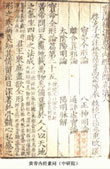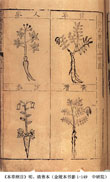|
TRADITIONAL CHINESE MEDICINE WITH A LONG HISTORY |
| A history of thousands years
Traditional Chinese medicine(TCM) has a history of thousands years. Its origin can be traced back to remote antiquity. In a long course of struggling against diseases, TCM evolved into a unique and integrated theoretical system of TCM. It is an important part of Chinese culture.Validate curative effect by several hundred millions Chinese in thousands years. |
 Huang Di Nei jing Huang Di Nei jing
|
Medical classic voluminousness
<<Huang Di Nei jing>>--the earliest medical classic
More than 2,000 years ago, came out Huangdi's Classic on Medicine( Huang Di Nei jing ), which is the earliest medical classic extant in China. It consists of two parts—Basic Questions ( Su Wen ) and Miraculous Pivot( Ling Shu ), each comprising nine volumes, each of which, in turn, contains nine chapters, totaling up to 162 chapters. The book gives a complete and systematic exposition to the following various subjects : the relationship between man and nature, the physiology and pathology of the human body, and the diagnosis, treatment and prevention of diseases. It also uses the theories of yin-yang and the five elements to deal fully with the principles of treatment by differentiation of syndromes (TDS) according to the climatic and seasonal conditions, geographical localities and individual constitution. Hence( giving expression) to the holistic concept of taking the human body as an organic whole and taking the human body with the surrounding environment as the integrity. It laid a preliminary foundation for the theoretical formation of TCM. |
| <<Nan Jing>> --Classic on Medical Problems
After Huangdi's Classic on Medicine another classic of medicine, Classic on Medical Problems ( Nan Jing ), was given birth to the world before the Eastern Han Dynasty. The book deals mainly with the basic theory of TCM, such as physiology, pathology, diagnosis and treatment of diseases and so on. It supplemented what Huangdi's Classic on Medicine lacked. From then on, many medical schools and various classics on medicine were brought into being in succession, each having its own strong points. |
| <<Shen Nong Ben Cao Jing>>-- the earliest book on materia medica
Shen Nong's Herbal ( Shen Nong Ben Cao Jing ), also known as Classic on the Herbal (Ben Cao Jing ) or The Herbal ( Ben Cao ), is the earliest book on materia medica in China, which appeared in about the Qin-Han Period with its authorship unknown. Not only does it list 365 medicinal item —among which 252 are herbs, 67 are animals, and 46 are minerals, but also divides them into three grades according to their different properties and effects. The book also gives a brief account of pharmacological theories—principal (jun ), adjuvant (chen ), assistant ( zuo ) and guide (shi ); harmony in seven emotions ( qi qing he he ), four properties of medicinal herbs ( si qi ) and five tastes of medicinal herbs ( wu wei ). |

Shang Han Za Bing Lun |
<< Sang Han Za Bing Lun>>--established the principle of TDS
In the Han Dynasty (3rd century AD ), Zhang Zhongjing, an outstanding physician, wrote Treatise on Febrile and Miscellaneous Diseases ( Shang Han Za Bing Lun ), which is divided into two books by later generations, one is entitled " Treatise on Febrile Diseases", ( Shang Han Lun ) , the other Synopsis of Prescriptions of Golden Cabinet (Jin Kui Yao Lue ) . The book established the principle of TDS(Treatment of Differentiation Syndromes:Technical Data System ), thereby laying a foundation for the development of clinical medicine. |

Jia Yi Jing |
<<Zhen Jiu Jia Yi Jing >> --the earliest extant work dealing exclusively with acupuncture and moxibustion
In the Western Jin Dynasty. Huang Fumi, a famous physician, compiled A-B Classic of Acupuncture and Moxibustion (Zhen Jiu Jia Yi Jing ) The book consists of 12 volumes with 128 chapters, including 349 acupoints. It is the earliest extant work dealing exclusively with acupuncture and moxibustion and one of the most influential works in the history of acupuncture and moxibustion. |
| << General Treatise on the Etiology and Symptomology>>--the earliest extant classic on etiology and symptoms .
The Sui and Tang Dynasties came into their own in feudal economy and culture. In 610 AD, Chao Yuanfan et al. compiled General Treatise on the Etiology and Symptomology. The book gave an extensive and minute description of the etiology and symptoms of various diseases. It is the earliest extant classic on etiology and symptoms in China. |
<<Xin Xiu Ben Cao >>--the first pharmacopoeia sponsored officially in ancient China
In 657 AD, Su Jing together with 20 other scholars, compiled Newly-Revised Materia Medica ( Xin Xiu Ben Cao ) , which is the first pharmacopoeia sponsored officially in ancient China, and the earliest pharmacopoeia in the world as well. |

Sun Si Miao |
<<Bei Ji Qian Jin Yao Fang>><< Qian Jin Yi Fang>>--representative works of medicine in the Tang Dynasty.
Sun Simiao (581-682 AD) devoted all his life to writing out the two books: Valuable Prescriptions for Emergencies (Bei Ji Qian Jin Yao Fang ) and Supplement to Valuable Prescriptions ( Qian Jin Yi Fang) . The hooks deal with general medical theory, materia medica, gynecology and obstetrics, pediatrics, acupuncture and moxibustion, diet, health preservationand prescriptions for various branches of medicine. Both books are recognized as representative works of medicine in the Tang Dynasty. Sun Simiao was honored by later generations as "the king of herbal medicine". |
| <<Bureau for Revising Medical Books>>--a special organ to proofread and correct the medical books in the Song Dynasty
In the Song Dynasty, more attention was paid to the education of TCM . The govment set up "the Imperial Medical Bureau" for training and bringing up qualified TCM workers. In 1057 AD, a special organ named "Bureau for Revising Medical Books" was set up in order to proofread and correct the medical books from preceding ages, and to publish them one after another. The books revised have been handed down till now and are still the important classics for China and other countries to study TCM. |
| Four medical schools in the Jin and Yuan Dynasties
In the Jin and Yuan Dynasties, there appeared four medical schools represented by Liu Wansu ( 1120-1200 AD ), Zhang Congzheng ( 1156-1228 AD), Li Gao ( l180-1251 AD) and Zhu Zhenheng ( 1281-1358 AD). Among them, Liu Wansu believed that "fire and heat" were the main causes of a variety of diseases, and that the diseases should be treated with drugs cold and cool in nature. So he was known as "the school of cold and cool" by later generations, Zhang Congzheng believed that all diseases were caused by exogenous pathogenic factors invading the body, and advocated that pathogenic factors should be driven out by methods of diaphoresis, emesis and purgation. So he was known as the "school of purgation". The third school represented by Li Gao held that "Internal injuries of the spleen and stomach will bring about various diseases". Therefore, he emphasizeed that the most important thing, clinically, should be to warm and invigorate thespleen and stomach because the spleen is attributed to the earth in the five elements. So he was regarded as the founder of the "school of reinforcing the earth". And the fourth school was known as the "school of nourishing yin" by founded Zhu Zhenheng. He believed: "Yang is usually redundant, while yin is ever deficient". That is why the body "often has enough yang but not enough yin". So he usually used the method to nourish yin and purge fire in clinical practice. |

Ben Cao Gang Mu |
<<Ben Cao Gang Mu>>--a monumental work in Materia Medica
Li Shizhen (1518-1593 AD), a famous physician and pharmacologist in the Ming Dynasty, wrote The Compendium of Materia Medica ( Ben Cao Gang Mu ). The book consists of 52 volumes with 1,892 medicinal herbs, including over 10,000 prescriptions and 1,000 illustrations of medicinal items. In addition, his book also deals with botany, zoology, mineralogy, physics, astronomy, meteorology, etc. It is really a monumental work in Materia Medica. It is a great contribution to the development of pharmacology both in China and all over the world. During the same period, acupuncture and moxibustion reached their climax. Many literature concerning acupuncture and moxibustion for the ages were summarized and developed. |
| Inheriting and developing the heritage of TCM
Since the founding of New China, the government has paid great attention to inheriting and developing the heritage of TCM and Materia Medica. A series of policies and measures have been taken for developing TCM. In 1986, the State Administrative Bureau of TCM and Materia Medica was established. This leading body is the guarantee of developing TCM and Materia Medica smoothly. Never before has TCM been as prosperous as it is today. TCM has experienced many vicissitudes of times but always remains evergreen. There is no doubt that TCM will take its place in medical circles of the world as a completely new medicine. |
|
|
|
|